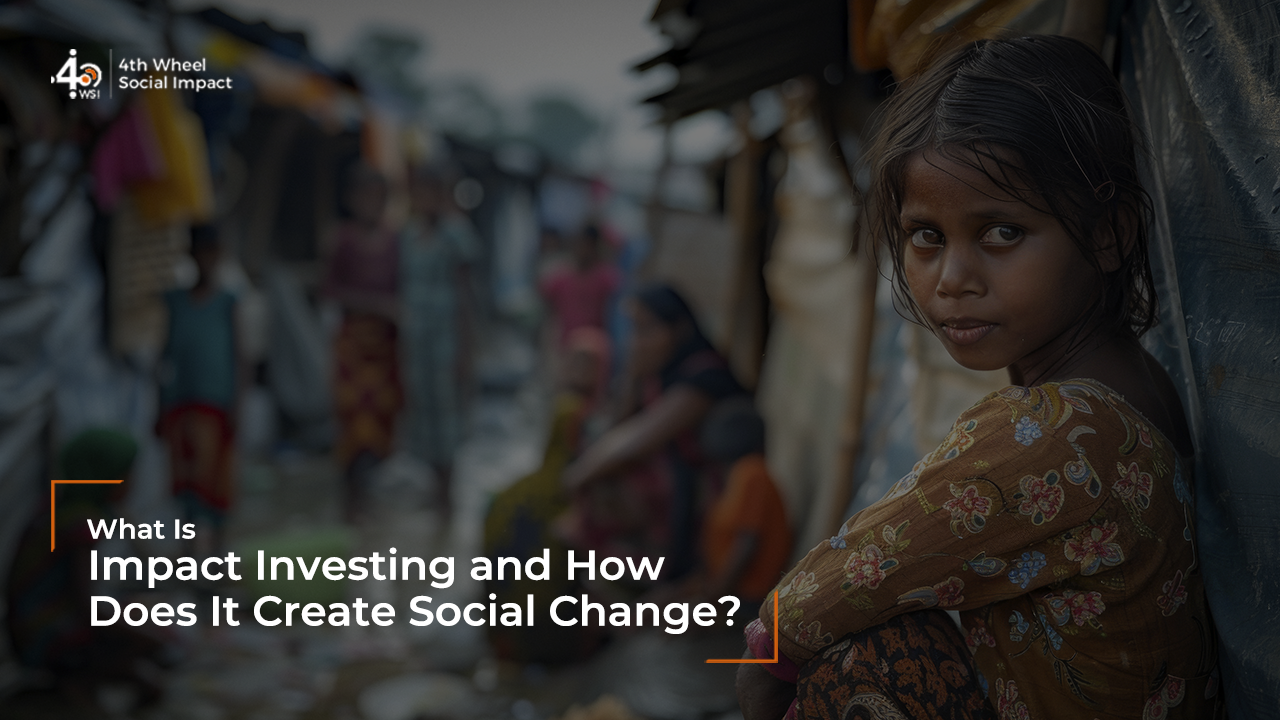Global socio-economic challenges need money and resources, and investors are looking for opportunities to contribute to social impact solutions. For many, the first question is what is impact investing and how it can help address these issues. Impact investing has emerged as a powerful approach that promises both financial returns and positive social or environmental outcomes. This investment strategy is reshaping how we view money, profit, and purpose, with ripple effects that go well beyond traditional portfolio performance.
Table of Contents
What Is Impact Investing?
Impact investing centres both financial returns as well as positive social impact. Unlike traditional investing, which primarily focuses on maximizing profits, impact investing intentionally seeks to address pressing global challenges such as poverty, climate change, healthcare access, and education inequality.
The impact of investment in this space goes beyond mere philanthropy. Impact investors actively seek opportunities to work with social impact firms where their capital can create tangible, measurable change while still earning competitive returns. This dual focus on profit and purpose has attracted a diverse range of investors, from individual retail investors to large institutional funds, all united by the belief that money can be a force for good.
How Does Impact Investing Work?

Impact investing operates through a structured approach that balances financial performance with social and environmental outcomes. Impact investors begin by identifying specific social or environmental problems they want to address, then seek investment opportunities that can generate both financial returns and measurable positive impact.
As part of the process, impact evaluation studies are used alongside financial assessments to gauge an investment’s potential to drive meaningful change. Impact investors use various metrics and frameworks to measure success, including social return on investment (SROI), impact measurement and management (IMM) systems, and standardized reporting frameworks.
These investments can take many forms, from direct equity investments in social enterprises to bonds that fund sustainable infrastructure projects. The key distinguishing factor is the intentionality behind the investment decision and the commitment to measuring and reporting on both financial and impact outcomes.
You may also read: How to Measure Social Impact: A Step-by-Step Guide
Types of Impact Investments
The investing environment for impact opportunities spans multiple asset classes and sectors, with diverse options tailored to different risk appetites and impact goals. . Understanding the different types of impact investing is crucial for anyone exploring this field.
1. Social Impact Bonds
Social Impact Bonds represent one innovative approach where investors fund social programs, receiving returns based on the achievement of predetermined social outcomes. These bonds have been used to fund education programs, homelessness reduction initiatives, and criminal justice reform efforts.
2. Green Bonds
Green Bonds focus specifically on environmental projects, funding renewable energy infrastructure, sustainable agriculture, and climate adaptation initiatives. These fixed-income securities have seen tremendous growth as climate concerns intensify globally.
3. Microfinance Investments
Microfinance Investments provide capital to financial institutions serving underbanked populations, particularly in emerging markets. These investments support small business development and financial inclusion initiatives.
4. Healthcare and Education Investments
Healthcare and Education Investments target companies and projects that improve access to essential services, from telemedicine platforms to educational technology solutions serving underserved communities.
Examples of Impact Investing in Action

The impact investing landscape showcases diverse real-world applications that demonstrate how impact investors create meaningful change while generating returns. These impact investing examples illustrate the practical implementation of impact investing strategies across various sectors and highlight the tangible impact of investment in addressing social and environmental challenges.
1. Tata Communication assessing the Social Return on Investment (SROI)
Tata exemplifies how established corporations approach social impact investing through systematic values-based investing practices. The company routinely invests in several social causes including education, livelihood, and renewable energy initiatives. One notable project where we collaborated with Tata Communications involved assessing the Social Return on Investment (SROI) for their MPOWERED project, designed to improve women’s livelihood opportunities, particularly targeting those struggling with extreme poverty and vulnerability.
This initiative demonstrates what is impact investing in practice – creating measurable social outcomes while maintaining financial sustainability.
The impact investing definition comes to life through Tata’s approach, which shows how impact investors can systematically evaluate and scale their social interventions.
2. Shapoorji Pallonji’s social impact investment in Maharashtra
Shapoorji Pallonji Finance Pvt Ltd represents another compelling example of impact investing in the financial services sector. Since 2020, the company has demonstrated the impact investing benefits through its collaboration with Swayam Shikshan Prayog (SSP) in Maharashtra. This partnership showcases different types of impact investing through two comprehensive programs:
3. Women Entrepreneurship Development Program
This initiative exemplifies social impact investing by providing capital and support to women entrepreneurs in rural areas. The program demonstrates how impact investing strategies can address gender inequality while creating sustainable economic opportunities.
4. Water Management and Conservation Program
This environmental initiative shows the impact of investment in sustainable resource management, addressing critical water scarcity issues while building community resilience.
These impact investing examples provide valuable insights for those exploring how to start impact investing, demonstrating that successful impact investing requires clear objectives, systematic measurement, and long-term commitment to positive change.
Interesting read: What is Social Impact Management? Why It’s Important in India?
How Impact Investing Creates Social Change
The impact investing definition encompasses more than just financial transactions; it represents a fundamental shift in how capital allocation can drive systemic change. Impact investing creates social change through several mechanisms that work together to address the root causes of social and environmental problems.
1. Scale and Sustainability
Unlike traditional charitable giving, impact investing provides sustainable funding models that can grow and adapt over time. Successful impact investing strategies can be scaled, replicated, and improved upon to create a lasting change that extends far beyond the initial investment period.
2. Market Development
Impact investors often fund innovative solutions that help develop new markets for social and environmental goods and services. By providing patient capital and accepting lower initial returns, these investors help prove market viability for solutions that might otherwise struggle to attract traditional funding.
3. Systems Change
Impact investing addresses systemic issues by funding organizations and initiatives that tackle root causes rather than just symptoms. This approach can shift entire industries toward more sustainable and equitable practices.
4. Innovation Catalyst
The focus on measurable impact encourages innovation in both business models and impact measurement, leading to more effective solutions and better understanding of what works in creating positive change.
Core Principles of Impact Investing

Understanding what is impact investing requires familiarity with its four core principles that distinguish it from other investment approaches.
1. Intentionality
This principle represents the cornerstone of impact investing. Investors must explicitly intend to contribute to positive social or environmental outcomes through their investments. This intentionality guides investment selection, structuring, and ongoing management decisions.
2. Investment with Return Expectations
This differentiates impact investing from philanthropy. Impact investors expect to receive financial returns on their investments, though these returns may be below market rate depending on the investment’s risk profile and impact potential.
3. Range of Return Expectations and Asset Classes
Range of return acknowledges that impact investing can target various financial return levels, from below-market rate returns to competitive market returns, across different asset classes including debt, equity, and guarantees.
4. Impact Measurement
This core principle requires investors to commit to measuring and reporting on the social and environmental performance of their investments. This accountability involves creating impact evaluation reports substantiate impact claims and learning that occurs across the impact investing ecosystem. if you also want toto understand about impact evaluation, so you can check our new blog on Impact Evaluation: What It Is and How It Strengthens Social Programs
Benefits of Impact Investing
Impact investing examples demonstrate numerous advantages for investors, society, and the environment. For investors, these impact investing benefits include portfolio diversification, potential for competitive returns, and alignment with personal values and long-term thinking.
1. Financial Benefits
Financial benefits of impact investing include access to growing markets, potential for stable returns in sectors with increasing demand, and reduced portfolio risk through diversification into impact-driven sectors that may be less correlated with traditional markets.
2. Social Benefits
Social benefits of impact investing encompass the satisfaction of contributing to positive change, building stronger communities, and addressing issues that investors care about personally. This alignment between values and investments often leads to more engaged and patient capital, demonstrating the impact investing benefits of values-based investing.
3. Environmental Benefits
Environmental benefits result from investments in clean energy, sustainable agriculture, and environmental conservation, contributing to climate change mitigation and environmental protection while potentially benefiting from the growing green economy.
How to Start Your Journey in Impact Investing
Learning how to start impact investing requires a systematic approach that begins with self-assessment and progresses through education, planning, and implementation.
1. Define Your Impact Goals
Begin by identifying the social or environmental issues you’re most passionate about addressing. This clarity will guide your investment selection and help you evaluate opportunities effectively.
2. Assess Your Risk Tolerance
Impact investing spans various risk levels, from conservative green bonds to early-stage social enterprise equity. Understanding your risk tolerance helps determine appropriate investment vehicles.
3. Educate Yourself
Familiarize yourself with impact investing terminology, measurement frameworks, and available investment options. Consider attending conferences, reading industry publications, and connecting with other impact investors.
4. Start Small
Begin with smaller investments to gain experience and understanding of how to start impact investing in practice. This will allow you to learn the ropes of social impact investing while limiting losses.
Seek Professional Guidance
Consider working with financial advisors who specialize in impact investing or investment platforms that focus on this area. Professional guidance can help navigate the complexities of impact measurement and investment selection.
The Future of Impact Investing
The impact investing benefits are driving significant growth in this sector, with projections suggesting continued expansion as awareness increases and more capital seeks purpose-driven opportunities in the evolving investing environment.
1. Technological Advancement
Technology is improving impact measurement and management, making it easier to track outcomes and demonstrate value creation. Blockchain technology, artificial intelligence, and data analytics are improving transparency and efficiency in impact investing.
2. Regulatory Support
Governments are recognizing the potential of impact investing to address social and environmental challenges. Policy frameworks are evolving to support impact investing while maintaining appropriate investor protections.
3. Institutional Adoption
This is accelerating as pension funds, insurance companies, and other large institutional investors integrate impact considerations into their investment processes. This institutional involvement is bringing significant capital and expertise to the impact investing space.
Conclusion
Impact investing represents a transformative approach to finance that recognizes the interconnectedness of financial performance and social outcomes. By intentionally seeking both profit and purpose, impact investing strategies offer investors the opportunity to align their financial goals with their values while contributing to positive change.
The growth of impact investing reflects a broader shift in how society views the role of capital in addressing global challenges. As this field continues to evolve, it promises to play an increasingly important role in creating a more sustainable and equitable world while delivering competitive returns to investors.
For investors seeking to make their money matter, impact investing offers a compelling pathway to create positive change while building wealth.
4th Wheel Social Impact supports impact investors in measuring returns and understanding on-the-ground outcomes through customized evaluation studies. Contact us today to learn how we can support you in your impact investing journey.
FAQs
Who should consider impact investing?
Various types of impact investing appeal to different investor profiles. Impact investing is suitable for individuals who want to align their investments with their values, institutional investors seeking diversification and long-term returns, and anyone interested in contributing to positive social or environmental change while building wealth
How is impact investing different from ESG and SRI?
The impact investing vs ESG distinction lies in intentionality and measurement. Impact investing explicitly seeks to generate positive social or environmental outcomes alongside financial returns, with rigorous impact measurement. ESG investing primarily focuses on risk management by avoiding companies with poor ESG practices.
Is impact investing risky?
Impact investing risks vary widely depending on the specific investment vehicle and strategy. Some impact investing opportunities, such as green bonds from established issuers, carry relatively low risk. However, risk levels are generally comparable to traditional investments in similar asset classes, and the diversification benefits of impact investing may actually reduce overall portfolio risk.
What are the objectives and goals of impact investing?
Impact investing aims to generate measurable positive social or environmental impact alongside financial returns. Primary objectives include addressing global challenges such as poverty, climate change, healthcare access, and education inequality while providing competitive financial returns.
How is impact investing different from traditional investing?
Traditional investing primarily focuses on maximizing financial returns with minimal consideration for social or environmental outcomes. Impact investing intentionally seeks both financial returns and positive impact, requiring additional due diligence, impact measurement, and ongoing monitoring of social and environmental outcomes.




